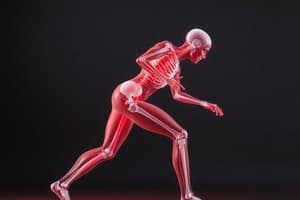Podcast
Questions and Answers
Kinesiology is the study of muscular movement.
Kinesiology is the study of muscular movement.
True (A)
Kinesiology focuses on the anatomic and biomechanical interactions within the cardiovascular system.
Kinesiology focuses on the anatomic and biomechanical interactions within the cardiovascular system.
False (B)
Anatomy is the science of the shape and structure of the human body and its parts.
Anatomy is the science of the shape and structure of the human body and its parts.
True (A)
Biomechanics uses principles of chemistry to study how forces interact with the living body.
Biomechanics uses principles of chemistry to study how forces interact with the living body.
Physiology is the biologic study of living organisms.
Physiology is the biologic study of living organisms.
Kinematics describes the motion of a body without considering the forces or torques that may produce the motion.
Kinematics describes the motion of a body without considering the forces or torques that may produce the motion.
Translation is a rotational motion in which all parts of a rigid body move parallel to and in the same direction as every other part.
Translation is a rotational motion in which all parts of a rigid body move parallel to and in the same direction as every other part.
Kinesiology primarily borrows from the sciences of chemistry, physics, and biology.
Kinesiology primarily borrows from the sciences of chemistry, physics, and biology.
Co-contraction occurs when the agonist and the antagonist muscles contract simultaneously.
Co-contraction occurs when the agonist and the antagonist muscles contract simultaneously.
A neutralizer muscle group helps execute a movement by contracting with the agonist.
A neutralizer muscle group helps execute a movement by contracting with the agonist.
The Gluteus Maximus is considered a neutralizer muscle for hip flexion.
The Gluteus Maximus is considered a neutralizer muscle for hip flexion.
Core muscles are primarily responsible for providing stability.
Core muscles are primarily responsible for providing stability.
Muscular Force Couple occurs when muscles produce forces in different linear directions resulting in torques acting in opposite rotary directions.
Muscular Force Couple occurs when muscles produce forces in different linear directions resulting in torques acting in opposite rotary directions.
In a lever system, opposing torques can balance each other only if the opposing forces are of equal magnitudes.
In a lever system, opposing torques can balance each other only if the opposing forces are of equal magnitudes.
The Iliopsoas is considered an antagonist for hip extension.
The Iliopsoas is considered an antagonist for hip extension.
Hamstrings are synergists for hip extension.
Hamstrings are synergists for hip extension.
Muscle fibers can range in thickness from about 10 to 100 mm.
Muscle fibers can range in thickness from about 10 to 100 mm.
Each muscle fiber is surrounded by the epimysium.
Each muscle fiber is surrounded by the epimysium.
Myofilaments are the basic components of muscle from the muscle belly to the individual contractile proteins.
Myofilaments are the basic components of muscle from the muscle belly to the individual contractile proteins.
Each myofibril within the muscle fibers contains many myosin filaments.
Each myofibril within the muscle fibers contains many myosin filaments.
The fundamental unit within each muscle fiber is known as the sarcophagus.
The fundamental unit within each muscle fiber is known as the sarcophagus.
Shortening of each sarcomere generates lengthening of the muscle fiber.
Shortening of each sarcomere generates lengthening of the muscle fiber.
Actin and myosin are examples of noncontractile proteins in muscle.
Actin and myosin are examples of noncontractile proteins in muscle.
Perimysium surrounds individual fascicles within a muscle.
Perimysium surrounds individual fascicles within a muscle.
Stress is defined as the internal resistance generated as a tissue resists its deformation.
Stress is defined as the internal resistance generated as a tissue resists its deformation.
Strain is the ratio of stress caused by an applied strain in the ligament.
Strain is the ratio of stress caused by an applied strain in the ligament.
Plasticity is the property of a material to return to its original length after the removal of a deforming force.
Plasticity is the property of a material to return to its original length after the removal of a deforming force.
Yield point is reached when increased strain results in only marginal increased stress.
Yield point is reached when increased strain results in only marginal increased stress.
Elasticity is the ability of a material to tolerate tension loads.
Elasticity is the ability of a material to tolerate tension loads.
The ability of connective tissue to partially resist changes in shape can be represented by a Stress-Strain Curve.
The ability of connective tissue to partially resist changes in shape can be represented by a Stress-Strain Curve.
Stiffness is the ratio of strain caused by an applied stress in the ligament.
Stiffness is the ratio of strain caused by an applied stress in the ligament.
Injured or weakened musculoskeletal tissues may resist external loads adequately.
Injured or weakened musculoskeletal tissues may resist external loads adequately.
Active force is produced by an activated muscle fiber being stimulated by the skeletal system to contract.
Active force is produced by an activated muscle fiber being stimulated by the skeletal system to contract.
Muscle contraction involves a simple physiologic and mechanical interaction between actin and myosin.
Muscle contraction involves a simple physiologic and mechanical interaction between actin and myosin.
The A band within a sarcomere contains actin thin filaments.
The A band within a sarcomere contains actin thin filaments.
The I bands, also called light bands, contain myosin thick filaments.
The I bands, also called light bands, contain myosin thick filaments.
The shortening of many sarcomeres in unison creates movement.
The shortening of many sarcomeres in unison creates movement.
The sliding filament hypothesis describes how actin filaments slide past myosin filaments during muscle contraction.
The sliding filament hypothesis describes how actin filaments slide past myosin filaments during muscle contraction.
The H band widens as actin and myosin filaments overlap during muscle contraction.
The H band widens as actin and myosin filaments overlap during muscle contraction.
The Z discs within a sarcomere move further apart during muscle contraction.
The Z discs within a sarcomere move further apart during muscle contraction.
Muscle fibers are the smallest functional subunits of the myofibril.
Muscle fibers are the smallest functional subunits of the myofibril.
Passive tension generated in muscles is not transmitted to the bones of a joint.
Passive tension generated in muscles is not transmitted to the bones of a joint.
Flashcards are hidden until you start studying
Study Notes
Muscular Interactions
- Co-contraction occurs when the agonist and antagonist contract simultaneously, providing stability to the joint.
- Neutralizer: a muscle or muscle group that counteracts unwanted motion at the joint.
Kinesiology Terminology
- Kinesiology: the study of muscular movement, especially the mechanics of human motion.
- Kinematics: a branch of mechanics that describes the motion of a body without regard to the forces or torques that produce the motion.
- Muscular Force Couple: when two or more muscles produce forces in different linear directions, resulting in torques that act in the same rotary direction.
Musculoskeletal Levers
- A lever is a simple machine that converts a force into a torque, consisting of a rigid rod suspended across a pivot point.
- Within the body, internal and external forces produce torques through a system of bony levers.
Musculoskeletal System
- The study of kinesiology focuses on the anatomic and biomechanical interactions within the musculoskeletal system.
Structural Organization of Skeletal Muscle
- Muscles consist of many individual muscle fibers, ranging in thickness and length.
- Contraction or shortening of individual muscle fibers is responsible for contraction of a whole muscle.
- The muscle belly is enclosed by the epimysium, individual fascicles are surrounded by the perimysium, and each muscle fiber is surrounded by the endomysium.
- Extracellular connective tissues help transmit contractile forces throughout the entire length of the muscle.
Muscle Components
- Myofibrils contain many myofilaments, composed of actin and myosin.
- The fundamental unit within each muscle fiber is the sarcomere, which generates shortening of the fiber.
- Contractile proteins within the sarcomere, such as actin and myosin, interact to shorten the muscle fiber and generate an active force.
Forces and Deformation
- Forces applied to the musculoskeletal system include tension, compression, bending, shear, torsion, and combinations.
- Healthy musculoskeletal tissues can partially resist changes in their shape due to forces.
- Injured, diseased, or weakened tissues may not resist loads adequately.
Stress-Strain Curve
- A "Stress-Strain Curve" depicts the inherent ability of connective tissue to tolerate tension loads, divided into elastic and plastic zones.
- Stress: internal resistance generated as a tissue resists its deformation, divided by its cross-sectional area.
- Strain: the percent increase in a tissue's stretched length relative to its original length.
- Stiffness: the ratio of the stress (Y) caused by an applied strain (X) in the ligament.
Muscle and Tendon: Generation of Force
- Contractile components: muscle belly, muscle fascicles/bundles, muscle fibers, and sarcomere.
- Active force is produced by an activated muscle fiber (contractile component), being stimulated by the nervous system to contract.
- Muscle contraction involves a complex physiologic and mechanical interaction between actin and myosin.
- The sliding filament hypothesis is the model for describing active force generation within the sarcomere.
Studying That Suits You
Use AI to generate personalized quizzes and flashcards to suit your learning preferences.




